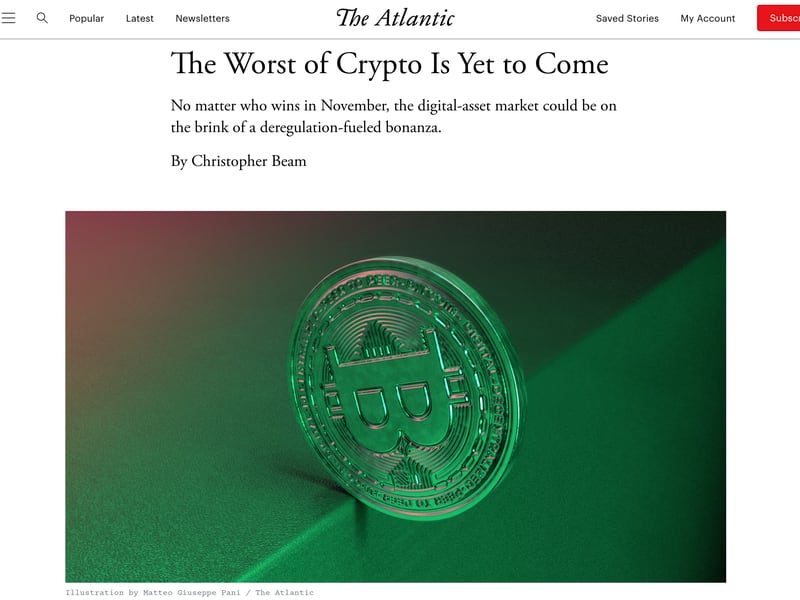Is your social media feed once again full of crypto bros taking victory laps attesting to the inevitability of bitcoin?
If you’re wondering, “How did we get back here?” or why TV news told you that Bitcoin died, you’re not alone. Driven by viral social media campaigns like Elizabeth Warren’s “Anti-Crypto Army,” crypto has become as dirty a word as investment banking was in the aftermath of the 2008 financial crisis. The crypto-is-a-scam crowdmay have sounded prescient as FTX blew up in 2022, but the kindest thing you can call these critics today is lazy.
Several areas within the crypto sector are solving tangible problems at scale, from facilitating digital transactions to supporting an internet-native financial system. For instance, stablecoins, which peg digital assets to fiat currencies like the U.S. dollar, are reaching new heights in adoption, particularly in emerging markets where people face unstable local currencies.
Then there’s decentralized finance (DeFi), which enables users to lend, borrow, and trade assets directly, bypassing traditional financial intermediaries. Yes, in countries with limited access to banking, DeFi represents a significant opportunity for financial inclusion. But in a world radically rethinking trade and dollarization, these primitives also offer a neutral ground to transact, while furthering use and proliferation of the dollar.
Not all crypto projects have clear value, however. Memecoins, digital tokens whose value is driven by internet attention rather than tangible use, are divisive — even within crypto circles. For example, dogecoin, a favorite of Elon Musk, has a market value exceeding 94% of companies in the S&P 500, despite lacking a product or business model. Recently, Chris Dixon, at Andreessen Horowitz, even criticized memecoins’ as undermining understanding of the sector’s utility. If one was looking for a reason to argue crypto is a scam, you could find it in pockets of the memecoin world.
But since Sam Bankman Fried’s ignominious fall in 2022, another new primitive is using crypto rails to rebuild the tangible world: decentralized physical infrastructure networks (DePIN). These networks let individuals contribute resources — such as data or connectivity — in exchange for rewards. By crowdsourcing infrastructure, DePIN projects can compete with large incumbents, offering cheaper and more accessible services.
The Atlantic has already called the term DePIN (which was coined by an analyst at Messari) “boring.” But these networks are already changing the market structure of legacy industries. Today, there are over 1,400 DePIN projects building, having raised more than $1 billion in venture funding. But if you relied solely on the Atlantic and Warren’s Twitter feed, you’d still think the industry was fraudulent.
One prominent example is Helium, a network that crowdsources mini-tower and hotspot deployment to create a decentralized mobile coverage network. With over 120,000 active mobile plans in service, Helium provides affordable connectivity by pushing operating costs to the edges of the network. But one could also find reporting calling Helium a scam and declaring it a failure after its token price fell 90% in 2022.
All of which misses how Helium’s business has transformed into a cellular provider from an IoT network. This misunderstanding reflects how volatile token prices often overshadow real business developments. Crypto networks like Helium are often “antifragile,” adapting through volatility, even as extreme price swings fuel misleading narratives.
Perhaps this explains Trump’s affinity for crypto: both he and the crypto industry are often misrepresented or taken out of context. Like with MAGA, certain crypto actors become conflated with the whole industry, and those looking for something to blame find an easy scapegoat. It also explains why crypto-natives feel so misunderstood.
Yes, there is a cohort of crypto-owners that support anarchy, and others still that have abused this unregulated market for personal gain. As the failures of the end of last cycle pushed the mainstream media to pessimism, it makes sense that many believe that The Worst of Crypto is yet to come. But as real use-cases in stablecoins, DeFi and DePIN continue to abound, it’s clear that the best of crypto is yet to come, too.
Note: The views expressed in this column are those of the author and do not necessarily reflect those of CoinDesk, Inc. or its owners and affiliates.

